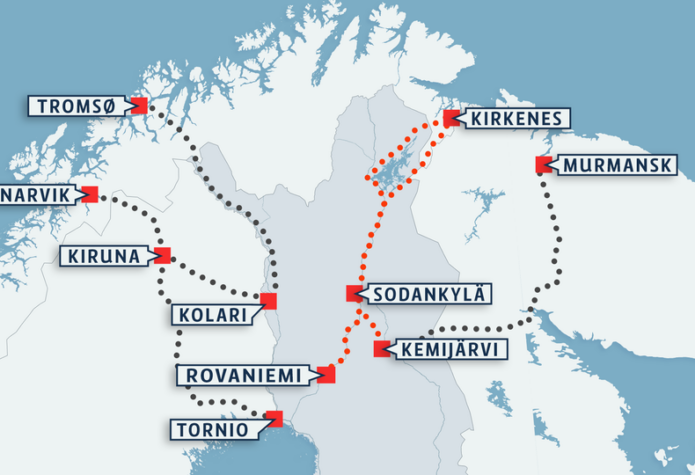The Arctic Railway project: connecting the Baltic to the Barents Sea

Economic interest in the Arctic has grown substantially over recent years. Soon, the region could provide access to major energy reserves and channels for global trade. A new railway connection linking Rovaniemi with the Norwegian coastal town of Kirkenes is now being considered as an alternative transport corridor.
Most transport between central Lapland and the industrial regions and ports of Arctic Norway and Russia primarily occurs on roads.
Establishing an Arctic railway line would open up new routes from Asia to the Baltic region and to the Barents Sea. This would improve the flow of goods and passengers, and create business opportunities to attract both domestic and foreign investment.
A recently published report by the Finnish Transport Agency and the Norwegian transport authorities explores five alternative rail routes connecting Finland with the Arctic Ocean, based in part on already existing lines. The route from Rovaniemi via Sodankylä to the coastal town of Kirkenes in northern Norway was judged the most viable option, and is to be examined further.
In an interview with NIB Newsletter, Marjukka Vihavainen-Pitkänen, Senior Adviser at Finland’s Ministry of Transport and Communications, discusses the outcome of the study.
When and how did the idea for an Arctic railway connection originate?
The Arctic railway is by no means a new idea; it has a rather long history. We have several maps dating back to the early 1920s showing plans for connections between Rovaniemi and Petsenga on the Russian Arctic Sea coast for instance.
In 2017, the idea was revived once again, and potential cooperation between Finland and Norway regarding a rail connection was discussed. This also initiated the most recent study on the feasibility of the project. The importance of the Arctic region is growing, and infrastructure improvements would promote growth and employment opportunities.

If this new connection would indeed be constructed, it could help transform Finland from being a “peninsula on the outskirts of Europe” to a transit country and route for goods.
Marjukka Vihavainen-Pitkänen
Senior Adviser, Ministry of transport and Communications, Finland
The recently published report highlighted the route from Rovaniemi to Kirkenes as the most viable alternative. What would the benefits of this railway connection be?
All alternatives that were examined are technically feasible. However, significant variations in terms of investment costs and environmental impact were identified. The route to Kirkenes stood out as a clear potential improvement for Finland’s logistical position, Lapland’s accessibility and supply security. If this new connection would indeed be constructed, it could help transform Finland from being a “peninsula on the outskirts of Europe” to a transit country and route for goods.
The connection would also improve conditions for many industries. Access to deep-water ports of the Arctic Ocean that are ice-free throughout the year also opens up a new connection to the Atlantic Ocean and the Northeast Passage.
The goods transported on the railway would include minerals, fish products, raw wood and wood industry products. Passenger volumes are expected to be boosted by tourism, which will most likely continue all year round in the future.
On the whole, the Arctic Railway is also an important EU project, as it would create a closer link between Northern, Arctic and Central Europe.
What is the estimated project cost?
Cost estimates of the routings vary significantly. The estimates are affected by the length of the new line and requirements of the terrain, for example. The overall costs of the rail lines vary between EUR 0.7–7.4 billion. Investment costs to be incurred on the Finnish side would be from EUR 0.02 to 2.3 billion.
The overall costs of the routing via Kirkenes are estimated at around EUR 2.9 billion, if the line will go from Rovaniemi via Sodankylä to Kirkenes. The investment costs would be around EUR 2 billion on the Finnish side and around EUR 0.9 billion on the Norwegian side.
The study has included considerations on how the project would affect the region’s Sámi population. How will this debate be taken forward?
It is evident that the routing via Kirkenes will have impacts on the environment and economy as well as the industry and culture of the Sámi people on both sides of the border between Finland and Norway. These possible consequences may have a pivotal role and importance for the local communities and the Sami people’s homeland.
It has been acknowledged that special attention should be payed to the questions of resilience of the local communities and indigenous people when considering land use plans in the future. It is of utmost importance to promote resilience in a broad sense by including indigenous people in the processes.
What will the next steps be?
A joint Finnish–Norwegian Task Force will examine the Arctic railway connection further. Special focus will be put on questions related to the chosen routing, such as environmental issues, permit procedures, costs, and finance structure and model.
The representatives of the Sámi people and the Skolt’s village association are invited to participate in the process. It is important that the voice of the indigenous people will be heard also during the next stages of the process.